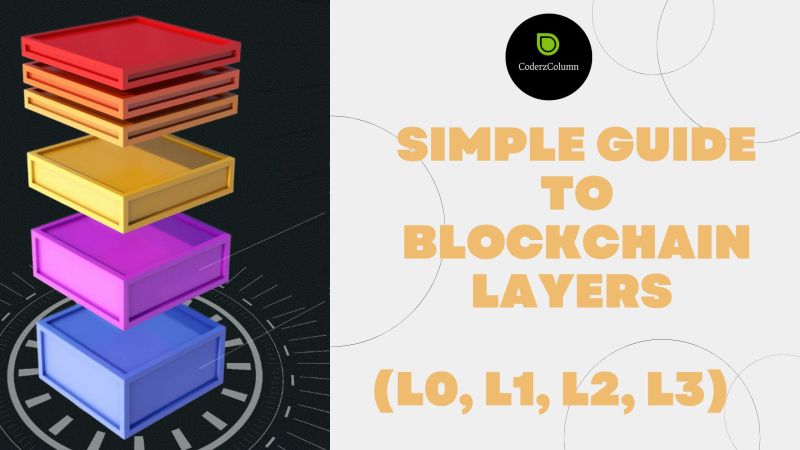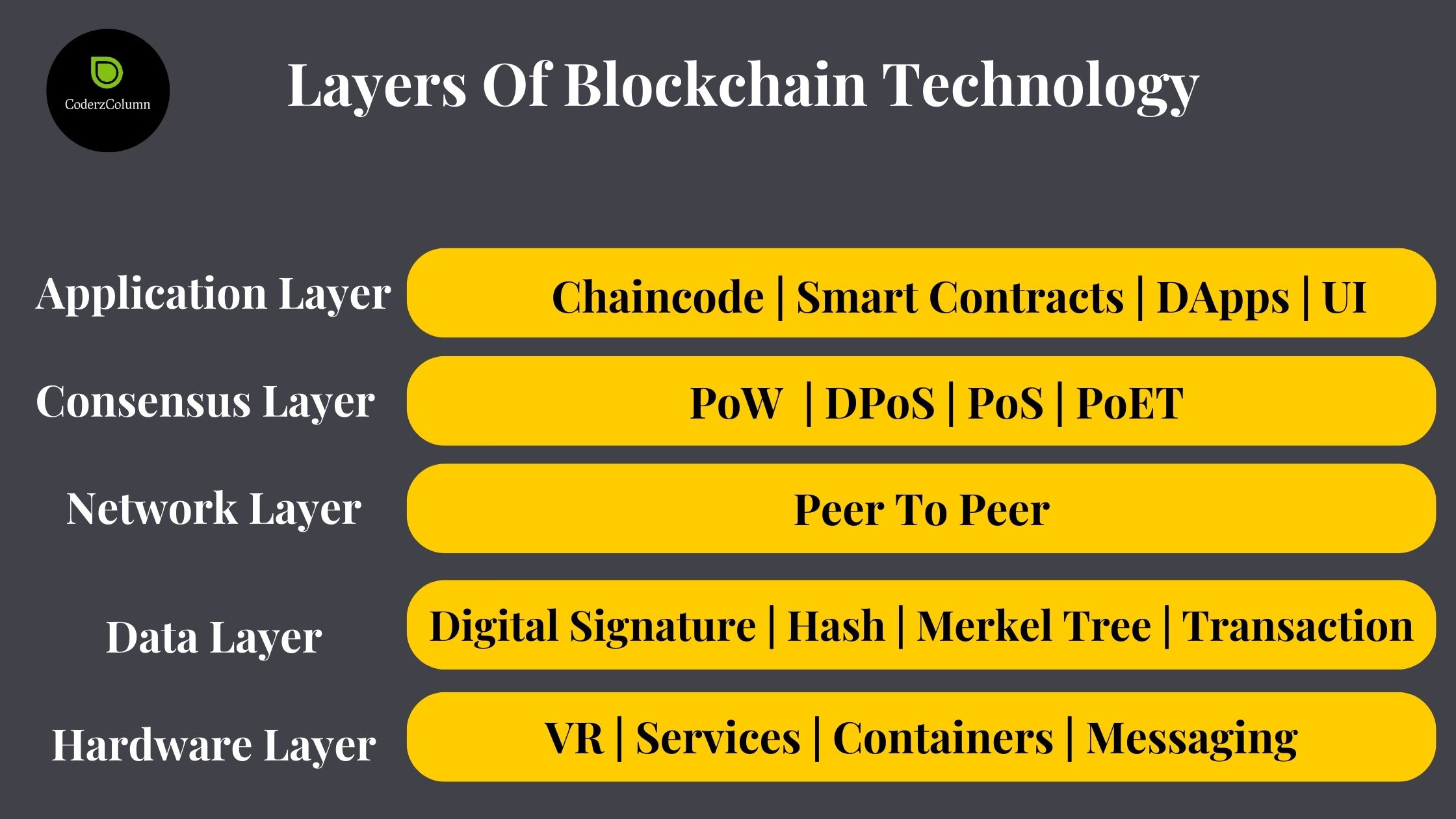
Simple Guide To Blockchain Layers (L0, L1, L2, L3)¶
Blockchain is a trending technology. Every other person you come across seems enthusiastic about the blockchain or cryptocurrency. People are crazy about investing in Bitcoin and other digital currencies (cryptocurrencies). Many IT businesses focus on building new use-cases for implementing blockchain functionalities. With everything positive around, still, some people are skeptical bout blockchain and its incorporation in various projects. It is because they do not have conceptual knowledge regarding blockchain technology. Before you get into the process of investment or building use-cases, it is essential to understand the blockchain functionalities and features. The very first thing that you should know is the layers incorporated in blockchain technology and its architecture.
Table Of Content¶
- Knowing About The Blockchain Technology
- Blockchain Technology Layers
- Understand The Blockchain Layer Stack In Detail
- Layer 0 Blockchain Architecture
- Layer 0s are allowing several things to happen
- Layer 0 Offers Faster and Affordable Transactions
- Layer 0 Provides Profound Infrastructure For Developers
- Layer 0 Provides Profound Infrastructure For Developers
- Layer 1 Blockchain Architecture
- What Are The Problems With Layer 1 Of Blockchain Architecture?
- What Are The Possible Solutions For The Problem?
- Layer 2 Blockchain Architecture
- What Is The Difference Between Two Layer 1 And Layer 2 of Blockchain Architecture?
- Understanding Layer Two Scaling Solutions In Detail
- Nested Blockchain of Layer 2 Architecture
- State Channels Of Layer 2 Blockchain Architecture
- You Can Check The Sidechain Of Layer 2 Architecture
- Sidechains
- Understanding The Roll Ups In Blockchain Layer 2
- Layer 3 Blockchain Architecture
- Can You Resolve The Blockchain Trilemma?
- Layer 0 Blockchain Architecture
- Conclusion
Knowing About The Blockchain Technology: ¶
While considering blockchain technology, you need to be familiar with the term “scaling”. Scaling means you have the flexibility to improve the throughput rate of the system. By throughput rate, we refer to the total number of transactions that took place in a split second. In simple words, it is called the number of transactions performed per second.
Cryptocurrencies are becoming essential currencies for various transactions. Many countries have adopted digital currencies for various purposes. Therefore, people are taking a keen interest in developing blockchain more and more securely. To enhance the security of blockchain technology, you have to understand the layers. The layers are responsible for building network security, improving record-keeping, and more. Are you curious to know more regarding the layers and why they exist?
Let's discuss blockchain layer architecture in this article. Blockchain technology is basically a perfect blend of various current technologies such as cryptography, security, game theory, and more.
Blockchain comprises complex concepts such as encoding and decoding data. It also includes multiple mathematical and computational disciplines that are popularly known as cryptography. With help of mathematical models, you can understand the strategic interaction among rational decision-makers is known as game theory. Blockchain technology usually aims to eliminate intermediaries, lowers overhead costs, and improve efficiency by enabling transparency and security.
Blockchain does not have any centralized authority. It is because they use distributed ledger technique - DTL to safeguard the records and verify the information through cryptography. When you combine all the functionalities and technologies, it becomes to foster trust among millions of users. Without complete security, people will not trust the services or the motive behind using the blockchain services. High-level security and technologies make it possible to exchange value and data between users.
Besides security, Blockchain must be scalable to manage the inflow of increasing users every day. When the number of users increases, the transaction will be innumerable. Blockchain layers are helpful in managing the scalability concurrent to the high-level security needs.
So let’s begin with understanding the layers of the blockchain and then move toward other topics.
Blockchain Technology Layers ¶
There has been a rise in the prevalent use of digital currencies. Besides, you can observe the acceptance of Bitcoin, use-cases developed on blockchain technology, and more. Creating layers in the blockchain is essential to maintain high network security. High security will help in reaching the development of record-keeping technologies. The layers in blockchain start with the lowest level 0 and then go up to 1, 2, and 3. These layers are referred to as L0, L1, L2, and L3. Layer 0 deals with the basic functionalities and features of blockchain technology.
Layer 1 comprises the decentralized ecosystem and its application. Layer 2 focuses on third-party integration and combines it with the features of Layer 1 to form nodes. You can witness the application of Layer 2 in the form of smart contracts and automated transactions.

Understand The Blockchain Layer Stack In Detail: ¶
Layer 0 basically deals with the ground floor functionalities and features of the blockchain. Layer 0 of blockchain technology focuses on the essential hardware, connections, and internet facilities. These features help Bitcoin to run efficiently and smoothly.
Layer 0¶
Layer 0s are allowing several things to happen:¶
- Layer 0 Helps The Blockchains To Interact With Each Other
The best example of blockchain interaction is Cosmos. Cosmos creates different ecosystems where you can find interoperable blockchains. It is possible due to the presence of ‘Tendermint IBC’ (Inter-blockchain communication protocol).
Blockchain developers consider Tendermint IBC as massive support. In simple words, if Dapp has the potential to function on on blockchain layer, it can easily function on other blockchain layers as well. The developers have to ensure that they’re built using the same layer 0. You do not need to invest more time and resources to build the same app on another chain.
Now you can understand that blockchain layer 0 is increasing the convenience of the developers.
Layer 0 Offers Faster and Affordable Transactions:¶
Blockchain technology layer 0 employs various concepts such as IBC, and PoS to achieve the consensus. You can achieve this with the help of multiple chains. Implementation of multiple chains results in finality times almost instantly. Many people are not aware of the term - finality. It is a technical term that refers to the situation when a block is approved, can’t be rolled back, and is considered irreversible. Layer 0 of blockchain makes the system faster and more affordable for transactions on cross-chain exchanges.
Layer 0 Provides Profound Infrastructure For Developers¶
Nowadays, the developers of blockchains do not have to break their heads and start from scratch to develop blockchains. The layer offers multiple functionalities and pre-built features to make development easy. The features help the developers to build blockchains that are ready to be implemented immediately.
Layer 1 Blockchain Architecture¶
Layer 1 is specifically designed for the blockchains - Bitcoin and Ethereum. The layer helps to improve the process of cryptocurrencies and finalize transactions on their own blockchain. In layer 1, you can formulate consensus (PoW, PoS) along with all the technical details like block time and dispute resolution take place. What is the most important aspect of Layer 1? Layer 1 has a crucial aspect that helps in acquiring the blockchain trilemma: decentralization, security, and scalability. To date, no blockchain has been able to nail all three factors.
What Are The Problems With Layer 1 Of Blockchain Architecture?¶
In layer 1 of blockchain, you can enhance the scaling solutions. It is helpful in boosting the network's throughput when used together. However, when the number of users will increase, layer 1 will fall short. It will not be able to handle the increasing traffic and the transactions. The proof f work consensus applicable in layer 1 will become clumsy and result in the malfunctioning of the architecture. The problems in layer 1 can have an impact on other layers as well.
You can approach different methods to enhance the functional efficiency of layer 1 of the blockchain architecture. Layer 1 is efficient in terms of security but experiences limitations in speed.
To obtain the blockchain cryptocurrencies, the miners have to solve the cryptographic code or algorithm with the help of computational power. Therefore, miners require high computational power and time to mine the blockchain currencies in the future. This will increase the load on Layer 1 as and when the users increase. It will slow down the process and capacities of the blockchain architecture.
What Are The Possible Solutions For The Problem?¶
To resolve the issues, you can make use of the Proof-of-stake consensus. This is basically an alternate consensus for Ethereum 2.0. With the help of this consensus, you can certify and validate new transaction data blocks. It is dependent on the staking collateral of network participants, resulting in a more efficient procedure.
Apart from this, you can employ the Sharding technique. Sharding refers to the scaling technique or solution that can eliminate the burden from Layer 1 of the blockchain architecture. The Sharding technique will divide the task of validating and authenticating transactions into shorter, easier-to-manage pieces. In simple words, the overall workload of maintaining the transactions will be distributed over the network. It will help in improving the computational capability of the layers in the blockchain architecture. The blockchain network will process the shards in parallel formation. Simply said, you will be able to validate multiple transactions both sequentially and simultaneously.
Layer 2 Of Blockchain Architecture:¶
Layer 2 specifies the third-party integrations that are applicable in conjunction with the features and functionalities of Layer 1. The integration is essential to increase scalability and transactions per second (system throughput).
Layer 2 of blockchain architecture comprises zero-knowledge rollups (zk rollups), side chains, or features associated with speeding up transaction throughput.
Layer 2 is also called the overlapping network that is situated above layer 1 strategically. Several protocols employ the functionalities of layer 2 to increase scalability. It does this by removing some interactions from the base layer or layer 1. Consequently, you can use smart contracts on the primary blockchain protocol. But it will deal with deposits and withdrawals. It will help you to ensure the off-chain transactions. These will help in following up with the transaction processes and following the regulations. The best network example for Layer 2 is Bitcoin's Lightning Network.
You might be wondering ………………………………………………..
What Is The Difference Between Two Layer 1 And Layer 2 of Blockchain Architecture?¶
In blockchain architecture, the first layer is associated with the decentralized ecosystem. Layer two deals with third-party integration to enhance the overall throughput through the use of nodes, features, and functionality.
Understanding Layer Two Scaling Solutions In Detail:¶
Layer 2 protocols of the blockchain architecture have enjoyed a lot of popularity because of their functionalities. The features and functionalities of layer 2 are highly competent and offer the most effective approach to solving scaling issues in PoW networks, in particular.
Various layer two scaling solutions are explained in the sections below.
Nested Blockchain of Layer 2 Architecture:¶
A nested layer refers to the two different layers that run on top of each other. In simple words, layer one establishes the settings and the layer above it will conduct the procedures. You can find multiple blockchain tiers on a single mainchain. You can consider it a typical business structure.
To understand the architecture of the nested blockchain layers, you can take this example. In an organization, the person responsible for managing a wide range of work will not do it single-handedly. He/she will delegate the task to subordinates. It will help in achieving the task at a faster speed and more efficiently. The subordinate will resort the task completion to the management. In simple terms, you are improving the scalability and reducing the workload of the managers.
An example of layer 2 nested blockchain is OMG Plasma Project. The project will work in the form of a level two blockchain for Ethereum's level one protocol. The project aims to offer affordable, faster, and more efficient transactions.
State Channels Of Layer 2 Blockchain Architecture:¶
A state channel is essential to improve the total transaction capacity and overall speed of layer 2. It is possible by facilitating two-way communication between a blockchain and off-chain transactional channels. You can do it through various approaches. In order to validate a transaction over a state channel, there is no requirement to involve the miners.
The state channel will use network-adjacent resources. These resources are protected by the multi-signature or smart contract mechanism. Subsequently, all the inherent transactions of the blockchain will be posted in the underlying section of the blockchain transactions. It is called the ultimate "state" of the "channel". What is the best example of the “State Channel”? The state channel offers Bitcoin Lightning and Ethereum's Raiden Network. In the trilemma tradeoff, state channels give up some decentralization in exchange for increased scalability.
You Can Check The Sidechain Applications Of Layer 2 Blockchain Architecture:¶
Sidechains¶
A sidechain refers to the transactional chain that will run alongside the blockchain architecture. The developers use it for massive bulk transactions. Sidechains employ their own consensus method, to adjust the speed and scalability. It also enhances the utility token as it is frequently utilized as a part of the data transfer mechanism between sidechain and main chains. The main chains employ different principal functions as it is applicable to provide general security and dispute resolution.
Sidechains are quite different from the state channels. The difference is stark and you will be able to understand easily. The sidechain transaction between two parties will always remain private. In the state channel ledgers, it will be open and transparent.
Furthermore, security breaches that take place on the sidechain will not have any effect on the mainchain or other sidechains. When you build up the sidechains from the ground up necessitates, a significant amount of time and work is required.
Understanding The Roll Ups In Blockchain Layer 2¶
Rollups refer to the blockchain scaling solutions applicable in layer 2. It is used to perform transactions outside the layer one network. Once you perform the transactions, the data gets uploaded from the transactions to the layer two blockchains. Layer one can keep rollups secure because the data is on the base layer.
Layer 3 Of Blockchain Architecture:¶
It is basically the application layer of the blockchain architecture. This is the UI that we as consumers actually interact with.
Can You Resolve The Blockchain Trilemma?¶
Before you can resolve the blockchain trilemma, it is important to understand what it is. Usually, distributed data storage face problem from the blockchains. In order to comprehend these difficulties and related problems in a better way, they termed it as a "blockchain trilemma". It was coined to group them.
The blockchain trilemma is merely a conjecture. Experts suspect this hypothesis to be accurate based on early data, but it has been neither proved nor disproved. More research needs to be done, even though layer one and layer two solutions have already had some success.

Conclusion:
CoderzColumn will always be there to help you enhace your knowldege on blockchain and other trending topics. Sp stay tuned!
 Dolly Solanki
Dolly Solanki
![]() Want to Share Your Views? Have Any Suggestions?
Want to Share Your Views? Have Any Suggestions?
If you want to
- provide some suggestions on topic
- share your views
- include some details in tutorial
- suggest some new topics on which we should create tutorials/blogs



 Want to Share Your Views? Have Any Suggestions?
Want to Share Your Views? Have Any Suggestions? blockchain-technology, blockchain-guide, blockchain-layers, blockchain-technology-simple-guide
blockchain-technology, blockchain-guide, blockchain-layers, blockchain-technology-simple-guide
